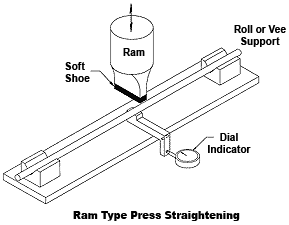How to Straighten Screws Basics
For users who elect to straighten their own screws or who need to straighten a bent screw, we offer the following guide.
Straightening methods which are suitable for plain (non-threaded) bars such as roll straighteners or crossed axis roll straighteners do a poor job on lead screws and should not be used. These methods are rarely accurate enough and can easily damage the lead screw threads.
For best results, we recommend press type straightening using a setup similar to that in Figure 36.
- The screw shaft is supported in vee blocks or cam type roller bearing supports and rotated so that the high spot of the bend is underneath the ram.
- The ram is driven manually (as with an arbor press or screw press) or hydraulically past the center of the screw axis until the screw yields to the bending stress imposed. Usually a number of straightening cycles are required until the target TIR is achieved.
- If snake or corkscrew defects are to be removed, then the support positions will have to be adjusted several times during the straightening operation.
- For production straightening, a good hydraulic press with controlled ram speed and controlled ram stroke is necessary.
- The support fixturing should be easily movable along the axis. The indicator is ideally located underneath the ram and it should have over- travel protection so that is does not need to be manually retracted between straightening strokes.
- The ram and supports should have soft shoes so that the lead screw threads are not damaged during the straightening process.
- Shoe material is usually brass or copper for steel work pieces and plastic or wood for softer screw materials like aluminum. The vee or roller supports should also be soft enough to avoid thread damage. Ram action should be smooth and controlled.
- The ram should push the lead screw gently bending it beyond the yield strength.
- A punching action with the ram is faster but much more difficult to control for accurate straightening.

FIGURE 36